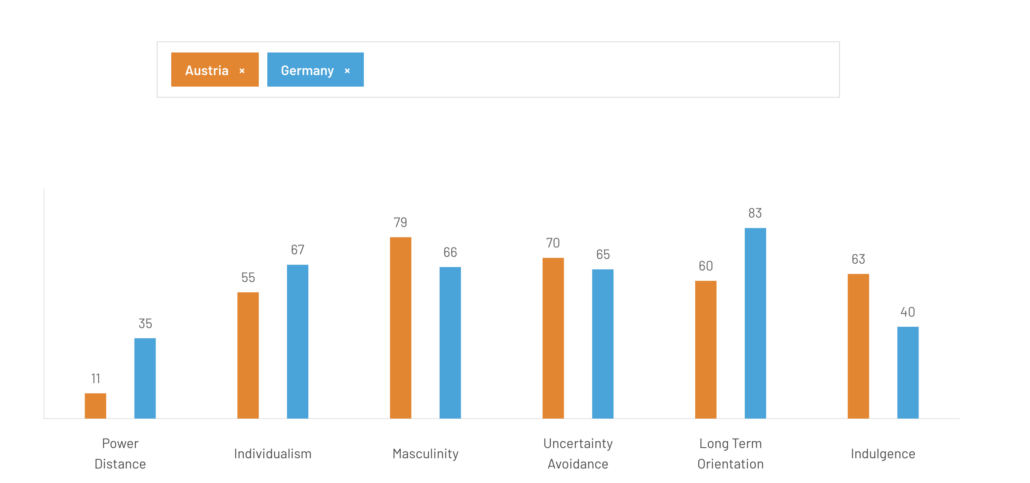Localising into German? Here’s why you shouldn’t forget about Austria
You might have decided to localise your website or product for the German market. Or you might be welcoming international employees into the company and want to address them in their first language. Either way, you’ve got a dedicated localisation budget (if not, this article might be helpful to you) and can’t wait to get started!
But the German market is huge – and it’s not entirely homogenous. That’s why you shouldn’t forget to check if you need to localise your content into Austrian German.
Austria is a Germanophone country with a population of close to 9 million – that’s not far off the entire population of London!
The standard of living is high, locals value high-quality products, and at least according to the U.S. Department of Commerce, its limited size and stable political situation make it an excellent test market.
Sounds like an attractive target market for your company? Great! But how do you reach Austrian customers?
By speaking their language.
Austria isn’t Germany’s little sibling. Austrians have their own culture, values and interests. Their identity is strongly tied to the Austrian German language variety. Be mindful of these differences and don’t miss out on engaging with a major segment of potential customers.
So, what are some of the main differences that your German localisation team should be aware of?
Lexical differences
It’s nearly impossible to discuss the lexical differences between Austria and Germany without quoting a famous line often attributed to Austrian writer Karl Kraus: “Was Deutschland und Österreich trennt, ist die gemeinsame Sprache” – “What separates Germans from Austrians is their common language”.
Germans and Austrians can express the same concept using a different vocabulary, just like people from the UK go on “holiday” but Americans go on “vacation”. These are not always hard and fast rules, but they are not negligible either because certain words and expressions make a text instantly recognisable as either using the German or the Austrian language variety.
This goes for individual words:
| German (Austria) | German (Germany) | English |
| Sackerl | Tüte | bag |
| Jänner | Januar | January |
| Bankomatkarte | Debitkarte | debit card |
As well as for collocations:
| German (Austria) | German (Germany) | English |
| Der Platz ist besetzt | Der Platz ist belegt | The seat is occupied |
| Der Wecker läutet | Der Wecker geht | The alarm rings |
And compound words, where Austrians tend to insert an -s-:
| German (Austria) | German (Germany) | English |
| Adventskalender | Adventkalender | Advent calendar |
This is definitely something your linguistic team should keep in mind when handling keyword research projects, for example. Austrians will spot the difference. They can tell whether or not you’ve made an effort to address them directly in your content which in turn helps to build trust in your brand. Experienced translators who are experts in the locale can help with this.
Read our tips on how to create successful international SEO here.
Localisation differences: Bank holidays and pricing
This might not seem relevant at first, nevertheless it’s important to note that some days are bank holidays in Germany but not in Austria, or vice versa. For example, the 8 December is Mariä Empfängnis (Feast of the Immaculate Conception) which is a bank holiday in Austria but not in Germany. Whereas Karfreitag (Good Friday) is a bank holiday in Germany only. Marketers can use this knowledge to their advantage in different ways: You could launch a campaign centred around a specific holiday or refrain from sending out business-related emails on certain bank holidays.
Furthermore, there may be country-specific legal requirements related to your product or service. Potential differences with regards to topics such as data protection or CBD products could apply to you – our German localisation experts handle legal-specific content on a day-to-day basis and would be more than happy to support you in your research.
VAT rates also differ between Austria and Germany: In Austria, a standard rate of 20% is applied to most goods and services, whereas in Germany it’s 19%.
It may also be valuable for you to know that at least at the time of writing, the inflation in Austria is somewhat above that in Germany causing an increase in pricing.
Cultural differences
According to Hofstede Insights, a cultural analytics tool that lets you compare countries across six different dimensions, Germany and Austria score similarly on “Individualism” and “Uncertainty Avoidance”, which means there is a strong focus on the nuclear family, self-actualisation, rules and laws. If you want to be mindful of these values when doing business in Austria (depending on your type of business and the people you want to address), you might want to pay attention to academic titles. Although younger generations may view this differently, many people still consider the use of titles as part of a person’s name as a necessary sign of respect.

However, Austria scores particularly low on “Power Distance” and significantly higher on “Indulgence” in contrast to Germany. Rather than a strict hierarchy, Austrians value personal relationships and networks. Thinking about an email campaign? An impersonal, one-size-fits-all or top-down communication style won’t get you very far. This also means that Austrians in general place a greater emphasis on leisure and enjoying life. If your product or service fits into this niche, it might be successful in Austria!
How do our translators localise for the Austrian market?
Our Senior German Translator & Language Lead and native Austrian, Melli, shares her insights into the localisation process and notes one significant difference between the two countries:
“When it comes to localising content for the Austrian market, it is crucial to recognise the socio-cultural disparities between Germany and Austria. Approaching the Austrian market effectively involves conducting comprehensive research as part of my work. One aspect to consider in this regard is the divergence in the education systems between the two countries which reflect dissimilar curricular, grading systems and examination structures (e.g. “Matura” in Austria vs. “Abitur” in Germany as the final school-leaving qualification). If you’re localising for the educational sector, e-learning materials for example, this is essential information to have at hand.”
At AJT we put a strong emphasis on localisation because we understand how neglecting this step can have unwanted outcomes for our clients. Unsuccessfully localised content can cause the end customer to disengage with your brand or form a negative opinion of it, which is the opposite of what we want for you! “My biggest no-go are German words like ‘Frikadelle’ for ‘meatball’”, notes Melli (in Austria you would say “Fleischlaibchen”).
So, what happens when we tailor the content to the target country, incorporating perspectives and language deeply familiar to the regional audience? It enables brands to foster an emotional connection with Austrian consumers. The quality of this connection will influence how your audience views your brand and how satisfied (and loyal!) your customers will be.
Are you looking for a German localisation partner to help you flourish in the Austrian market? We work with experienced native translators to make sure your message makes its way across the Alps successfully. Get in touch today and we’ll help you align your message with the relevant audience(s), give you our insider tips, and map out a localisation strategy that centres and enhances your unique brand voice.
